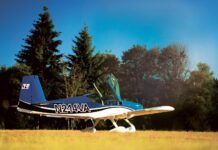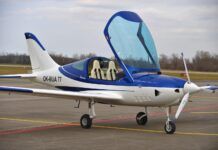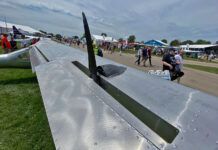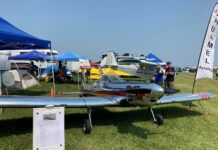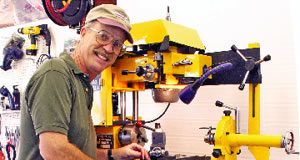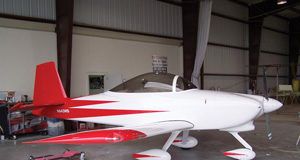An article on product reviews by editor Rob Sheppard in the September 07 issue of Outdoor Photographer struck an immediate chord with me. He noted that every reader has certain expectations-based on the readers own experience and preferences. And no product reviewer who goes beyond a purely technical analysis writes without those same human qualities, biases and limitations.
In aircraft, pilots develop preferences often related to their training and initial experience: high-wing/Cessna Skyhawk; low-wing/Piper Cherokee, for example. In my case, however, despite learning/instructing in and owning high-wing Cessnas, I developed an early appreciation for light, responsive controls after checking out in and renting the original American Aviation AA-1A Yankees, which were small, fast and might bite if slowed too much.
The Remos G3
This background came to mind as I reviewed notes on my Remos G3 600 evaluation flight last summer at AirVenture/Oshkosh. The Remos G3, an FAA-approved, German-manufactured Light Sport Aircraft (SLSA) flies wonderfully, but I found what I thought might be a potentially significant detriment. More on that in a moment.
Made mostly of carbon fiber including the landing gear, the Remos weighs only 625 pounds empty, leaving an especially large useful load of 695 pounds. Even with full fuel (22 gallons), there is room for two large people (250+ pounds each) and some baggage unless the G3 has been equipped with weighty options.
Powered by the usual Rotax 912ULS 100-horsepower engine swinging a two-blade wood propeller, the Remos was introduced in 1998 and was proclaimed
Aircraft of the Year at the biennial AERO sport aviation show in Friedrichshafen, Germany, in 2000. Several hundred G3s-mostly in Europe-are flying now. I was told there have been no structural failures, no fatalities and more than 20,000 student landings without gear failure.
Some features are unusual. The cockpit is reinforced with Kevlar. Structural composite wing parts are covered with Ceconite fabric to reduce weight. The strutted wings fold back in 5 minutes, reducing required hangar space. The Remos G3 is approved to tow gliders up to 625 pounds gross and banners up to 1633 square feet. (The pilot of course needs a commercial pilots license to charge for these services.)
Ailerons and the elevator are mass-balanced, and there is some rudder surface forward of the hinge, which reduces the pedal force required. Aileron differential of about 1.5:1 (more up than down aileron) also reduces footwork. Flaps extend to 40. The fuel
tank is high in the aft fuselage, and the filler is easily reached when standing on the ground. Shoulder width in the cabin is 45.8 inches, considerably wider than many other two-seaters.
Doors, which are hinged on top, may be opened in flight to 66 knots. They can be removed before takeoff, and the plane may be flown at any speed. Thats a bonus for instructors and students in hot climates such as Florida.
Lets Fly It
My Remos checkout was with Cris Ferguson, an instructor with Orion Flight Services, a new Remos dealer. This large new FBO is on the north side of Wittman Field, home of the EAA and AirVenture. After a routine preflight for a Rotax 912-powered aircraft, we started the engine and headed for the line of departures, using AirVenture standard procedures: Watch the wand-bearing ground controllers and listen, don’t talk.
Direct nosewheel steering is easy and comfortable. Ferguson said he would operate the wheel brakes as I steered. At the end of the flight, I found out why he chose to operate the brakes. The T-handle for non-differential braking is different; you push rather than pull for brakes. But Ive found that if things are done slowly, pilots can adapt easily to new situations.
Finally cleared for takeoff, I eased the stick back at about 35 knots, and we were airborne after a few hundred feet of runway roll. Company specs say you will use 330 feet to lift off and a total of 600 feet to clear a 50-foot obstacle once you get good at it. Cruise climb at 97 knots showed 5000 engine rpm, and the VSI indicated a 600- to 700-fpm ascent. Leveling near 2000 feet msl and reducing power to 4750 rpm yielded 106 knots indicated.
From the outset I was impressed with the light, balanced control in all three axes. Some rudder pedal pressure is needed with aileron input to keep the ball centered, which is ideal for student training. Roll rate at cruise speed is quick for an LSA: less than 2 seconds from 45 of bank one way to the other 45 bank. The LSA standard requires positive pitch stability, which the Remos demonstrated after I raised the nose, released the stick and watched as it returned to cruise airspeed and attitude in one well-damped cycle.
Stall and other speed checks came next. (Incidentally, to be consistent with other flight reports in this column, I am reporting speeds in knots even though the airspeed indicator showed mph.) The departure stall-with power less than full-revealed heavy pre-stall buffeting at 35 knots. Full-flaps power-off approach yielded an easily recovered stall at 40 knots, which is well under the 45-knot LSA maximum. At full 1320-pound gross weight, I estimate that the approach stall would still be under the LSA maximum. Full power at 2500 feet yielded 116 knots; 120 knots is the top level speed allowed. Slow flight at 45 knots clean is comfortable. Ailerons work well there.
Heading back to Wittman Field, we entered the demo flight pattern. That eventually led to right base and a final approach to Runway 36R (normally a Wittman Field taxiway) and clearance to land on the famous green dot, which is almost halfway down the taxiway, er, runway. A bit of coaching from Ferguson in the left seat resulted in a graceful touchdown and rollout to join the ground stream of arrivals to the worlds busiest airport (during AirVenture).
Visibility Problem?
Getting back to my original concern. The Remos is a joy to fly, but I was initially quite worried about pilot visibility to the side. Being short of leg length, I opted for the most forward of the three ground-adjustable seat positions. In this position, my sitting height, which is well proportioned (meaning also short), required me to duck a few inches to look level out the side window as required before turning in this high-wing airplane. The top of the window was about an inch below my eyeballs when I sat up straight. Also, the forward sitting position precluded using the skylight to see inside the turn; the front edge was behind my head. Hmmm. Thats not ideal. Further research was needed.
The Remos folks at the display booth helped. First, we positioned the seat in the middle of the three positions, and I climbed in. Thats the position I should have used. My legs are long enough for full deflection of the pedals, and the middle position also lowers the seat several inches. Now I could see left or right without ducking or hunching.
Each seat is positioned and locked in place by using one of three sets of four holes that correspond to telescoping tubes at each corner of the seat. On the theory that short people will benefit from sitting both forward and higher, the forward four-hole set is highest, and the aft set (for longer legs and more sitting height) is lowest.
For me the middle set worked well, but the question remained: How tall can you be and not have to duck under the window? I had noticed that Ferguson, who is 6-foot-2, needed to lower his head to see abeam. So we gathered recruits of various heights to sit in the Remos aft-seat configuration. As suspected, 6-footers come in various sitting heights, which we illustrated by having a pair of them sit in the airplane together. One 6-footer could see abeam by simply turning his head, and the other one needed to duck a bit.
Bottom Line
The Remos G3 illustrates a long-endorsed policy: Try before you buy. Sit in any airplane you are thinking of buying or flying, and check out visibility. One of Remos seat positions will work for most people. If they fit and can see out, they are likely to enjoy flying the Remos as much as I did.
As for buying, the airplane is imported by Remos Aircraft of Punta Gorda, Florida,where Phil McCoy answers emails ([email protected]) and the phones. At press time, Remos had eight dealerships and was looking to add more. Base price in the U.S. is $99,500 including a lot of features and basic instruments but not avionics or flat-panel displays, available as options.
For more information, call 941/629-6326 or 614/975-5788 (cell) or visit www.remos.com. A direct link can be found at www.kitplanes.com.



